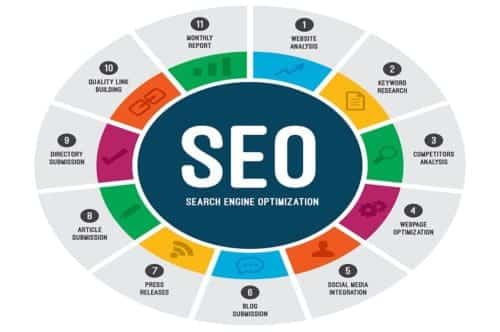Out-trafficking your competitors online is perhaps the toughest challenge in today’s business. Online shopping is now the way of the consumer; therefore, a business must adapt, and adapt proficiently if it wants to thrive. The most surefire way to increase web traffic is through on-page SEO.
On-page SEO requires extreme dedication and discipline, but it is your best bet to get your web pages to the top of search engine rankings.
First, we will detail on-page SEO so that you have a solid understanding as you read on. Then, we’ll offer up a few tips that should help you climb search engine rankings.
What is on-page SEO?

What Is On-Page Seo And How Do You Master It?
Essentially, SEO (Search Engine Optimization) is exactly as it sounds. The idea is to create optimal content and code in order to rank your site high on SERPs (Search Engine Results Pages). On-page SEO is irrelevant to external links, social media advertising or general marketing. Rather, it pertains exactly to what you create. You create the content and you clean up the code. If you do these things well, then you have yourself a fully-optimized site page that should flaunt on the first page of Google.
How do you fully optimize your webpages?
The key is to think like a targeted reader
Don’t overthink it…create content that one of your targeted readers would want to read.
How do you approach a web page when you click on it?
You probably want it to:
- Load immediately
- Get to the point
- Show good grammar
- Provide the answer(s) you are looking for
There you have it! The keys to quality content! Now, how do you approach those keys from an on-page SEO standpoint?
Load immediately
Whatever you have to do to get your website to load immediately, do it. Whether you have to change hosting sites or make use of a content delivery network, site speed plays a crucial role in your website’s livelihood. Frankly, the average attention span is lessening by the second in our online-reliant world. A visitor who has to wait a handful of seconds for content to populate will likely exit out and click on another link. Just like that, you’ve lost a potential customer.
In addition, it is essential for your website to be responsive. Responsive, meaning easy to view and navigate on all technological platforms. This consists of laptops, desktops, tablets and cell phones. Tablets and cell phones are the primary access points to websites. Thus, you do not want your website to struggle on those platforms.
Get to the point
Every page or post should have a “focus keyword”. The focus keyword is what the page or post is about. It can be one word or it can be multiple words. A multi-word focus keyword, also known as a longtail keyword, is generally more effective than just a single word. For example, “kitchen countertop designs” will strengthen the scope of a reader’s search much more so than “kitchen”.
You should mention the focus keyword at some point within the first 100 words of the post. Also, include it in an H2 tag within the post. Search engines like it when a focus keyword stands out, as it connects the viewer with the applicable topic.
There is no need to sugarcoat a topic. Bells and whistles are nice; however, you have to understand that most consumers are searching for answers. They are not looking for the kind of thrill that they would otherwise find in a Harry Potter novel. Rather, they want to find out right away whether or not the link that they clicked on will help resolve a need or an inquiry.
Use good grammar
Visitors want the satisfaction that they are visiting a credible, professional website. Grammatical errors are the easiest way to fail those criteria. Grammatical errors are also very easy to avoid. Just be sure to proofread your content multiple times through and make the necessary adjustments along the way. It is important to realize that what you publish can be seen by anyone and everyone; therefore, publish work that you are proud of and don’t let little mistakes turn away a visitor.
Provide answers
Lastly, and perhaps most importantly, provide answers to your readers. There is a reason a reader is on your page. The reader searched something on Google and clicked on a link to your website because he/she felt it would provide the answer he/she was looking for. A visitor has arrived, now make sure the visitor stays and converts to a sale or a lead.
You select your own keywords for a reason: so your website will trigger when a particular word or phrase is typed into a search bar. Thus, as long as you stay on topic to the keyword, your web page should fulfill the expectations of the visitor.
But, you should also try to think like Google

What Is On-Page Seo And How Do You Master It?
Google has a secret algorithm which ranks content wherever it is ranked. While the algorithm is unknown, everything already mentioned and everything to be mentioned is based on experience—trial and error. High search rankings have resulted from specific on-page SEO.
Search engines account for the content as a whole. After all, it is a search engines’ responsibility to match searches with the content which it feels is most helpful to a searcher. With that said, search engines consider many other aspects of a web page, such as:
- Slug
- Meta Description
- Internal Links
- Multimedia
Title Tag
Your title tag is how your page or post will appear on a given search engine. This is important as the title tag is what viewers will potentially be drawn in by. The focus keyword should always be included in the title tag and the title tag should be no more than 60 characters. Specifically, you want viewers to see their searched topic as soon as possible in the title.
You also want the entire title to appear on the results page. Title tags ending in “…” obviously don’t tell the whole story of the post topic. You should also include your Dallas, TX business name somewhere in the title tag, either at the beginning or end.
Slug
The slug is the part of the permalink that follows your domain. Moreover, it is the part of the link that specifies a web page and that can be customized for user-friendliness. You don’t want a slug with a bunch of random numbers in it; instead, you want one with wholesome words that comply with your post topic. Of course, the focus keyword should always be included in the slug. Lastly, create a slug that is concise. Concise slugs that include only the important title words will play favorably to Google.
Meta Description
The meta description goes hand in hand with the title tag in terms of importance. It is basically a 1-2 sentence summary that appears below the title tag and permalink on a SERP. Viewers will often read the meta description to determine whether or not the post is applicable to their need. Hence, its extreme importance.
Again, these little things can make a huge difference in clicks. Always think “concise” when working on meta information. A concise title tag with a concise slug and a concise meta description will help your search engine page rankings. Always include your focus keyword in each and keep your targeted viewer in mind.
Internal Links
Internal links are opportunities to get viewers to click onto other links to your website while reading through a particular post. You can include a link to your company service page, or perhaps to another relevant blog. You incorporate internal links by highlighting a word or phrase in your post and then linking that word or phrase by copying and pasting the link.
Just be sure the link flows with the post; you do not want to force internal links into a post. Google likes to see a few internal links used throughout a post, as they can be of added benefit to a reader.
Multimedia
Back to the importance of considering the reader…
As a hypothetical, which blog post seems more intriguing? One with 1,000 words top to bottom with no images or one with 1,000 words that is broken up with one or two images and maybe a helpful video? I think you know the answer.
Images and videos are engaging. They open up the page and they give a reader the chance to take a slight break while reading through the page. Therefore, you should take advantage of images and videos whenever possible. You should not overuse them but include them strategically to make for a more appealing and easier read.
It is also important to note the composition of an image. Each image can be customized in size and will include an “alternative text”. You should always include the post’s focus keyword in the alt text and be sure to size any image appropriately.
The bottom line…

What Is On-Page Seo And How Do You Master It?
Everything listed above is meant to align with Google’s algorithm. Research and application has proven all of the above to help rank web pages high on search engines. That’s what you want, right? For each page within your website to rank highly? If you can manage this then you will see a tremendous increase in traffic to your website. And an increase in traffic leads to converted customers and overall business growth.
On-page SEO is a free way to rank your website. You simply have to be disciplined and be dedicated to producing high quality, related content and you have to ensure the content is properly advertised on search engine results pages. If you execute those two things then you should see significant results in regard to on-page SEO and overall search ranking.
Click4Corp operates to help businesses grow. We achieve such a goal through expert on-page and off-page SEO. Certainly, you can master the power of on-page SEO! All it takes is repetition and commitment! However, we understand that you may have many other responsibilities in keeping your business operational and trending up. So, if you would like expert assistance in improving business on the digital marketing platform, contact Click4Corp at (469) 441-4678. Feel free to visit our website, www.click4corp.com, and please visit our blog for additional helpful digital marketing input.
